Category: Candidate Attraction
Beyond Intuition: Data-Driven Employer Branding for the Modern Talent Landscape
With the research today’s candidates do before applying, a strong employer brand is no longer a nice-to-have—it’s essential. Your employer brand directly impacts your ability to attract and retain top talent, yet for many talent acquisition leaders, demonstrating the value of employer branding remains challenging.
How do you quantify something that often feels intangible? How do you translate employer brand sentiment into metrics that resonate with stakeholders outside HR?
The Employer Branding Paradox
Despite 80% of HR leaders believing employer branding significantly impacts their recruiting efforts, only 8% report having a dedicated budget for these initiatives. This disconnect highlights a fundamental challenge: without concrete metrics and benchmarks, employer branding can be relegated to a “nice-to-have” rather than recognized as the strategic driver of recruitment success that it truly is.
The reality is that today’s candidates approach job searches with consumer-like behavior. They research, compare and evaluate potential employers with unprecedented thoroughness.
Your employer brand is front and center whether you’re actively managing it or not.
From Gut Feel to Data-Driven Strategy
For too long, employer branding has relied on subjective assessments and anecdotal evidence. Leaders might know intuitively that their brand needs improvement, but without comparative data, it’s difficult to:
- Identify specific areas requiring attention
- Prioritize investments for maximum impact
- Demonstrate ROI to key stakeholders
- Track progress over time
- Understand how you stack up against competitors
This is precisely why we’ve developed the Outthink Index—a proprietary benchmarking tool designed to transform employer branding strategy from an art to a science.
Introducing the Outthink Index by PeopleScout
The Outthink Index by PeopleScout provides comprehensive analysis across nine critical components of employer branding:
- Search: Are your job openings easy to find in digital spaces?
- Social Reach: What’s the breadth of your social media footprint? Are you achieving significant reach through interactions and engagement across audiences?
- Social Authority: How much of the conversation does your brand own compared to competitors? How influential is your voice in the talent marketplace?
- Social Impact: How effectively does your content engage your audience? Are you interacting with your talent audience on social media or just posting?
- Values & Proposition: How clearly articulated and differentiated is your EVP? Are your values clear, authentic and evidenced?
- Employee Experience: Can candidates get a clear understanding of what life is like within your organization?
- Content: How compelling and relevant is your employer brand content? How authentically does it showcase your organization and your employees?
- User Experience: How seamless and intuitive is your career site and application process?
- Candidate Experience: How transparent, consistent and innovative is your recruitment process?
Built by our in-house talent advisory experts and leveraging data from hundreds of employer brands, the Outthink Index delivers actionable insights with just a few clicks.
Translating Insights to Action
One of the most valuable aspects of the Outthink Index is its comparative nature. While self-assessment can identify obvious gaps, true optimization comes from understanding how you measure against both industry benchmarks and specific competitors.
The real power of data-driven employer branding isn’t just in the metrics—it’s in what you do with them. The Outthink Index is designed to facilitate more productive conversations with stakeholders by providing concrete evidence of:
- Current employer brand strengths and weaknesses
- Competitive positioning within your industry
- Specific improvement opportunities with the highest potential ROI
- Progress tracking over time
The Outthink Index helps companies to transcend gut instincts and harness concrete insights to maximize their employer brand. It provides organizations with precise visibility into how their brand measures up against competitors, highlights specific enhancement opportunities, and ultimately strengthens their capacity to attract and retain exceptional talent.
Armed with these insights, talent leaders can make more strategic decisions about where to invest resources, how to refine messaging and which touchpoints in the candidate journey need the most attention.
The Future of Employer Branding is Data-Driven
Employer branding isn’t a one-time project but an ongoing strategic initiative. The Outthink Index provides both a snapshot of current performance and a framework for optimizing and measuring progress over time. By establishing clear benchmarks today, organizations can track the impact of their employer branding initiatives, demonstrate concrete ROI and continuously refine their approach.
As the competition for talent continues to intensify, organizations that take a data-driven approach to employer branding will gain a significant advantage. The Outthink Index by PeopleScout equips talent leaders with the tools they need to transform employer branding from an intangible concept to a measurable business driver.
Want to see how your employer brand stacks up? Explore the Outthink Index or contact us to receive your custom report.
Wates: Reconstructing Industry Perceptions Through Vibrant Employer Branding

Situation
The construction industry’s image has remained virtually unchanged for years—dominated by hard-hats, high-vis, and steel beams rather than stories highlighting inclusion, innovation, collaboration or opportunity.
When Wates, a UK development, building and property maintenance company, needed to recruit 81 trainees across 21 roles and 28 locations, our priority was to stand out meaningfully in a crowded market. Despite its impressive 125-year legacy as an industry leader, Wates suffered from limited brand awareness.
Our objectives were clear:
- Raise overall awareness of the Wates organization
- Encourage a shift in industry perception
- Attract a more diverse range of candidates
Solution
With these hard-to-fill roles distributed nationwide, we needed a targeted approach. Based on research, we developed four distinct audience personas that represented our target demographics, which then informed our channel strategy and creative approach.
Authentic Messaging
We crafted a new compelling, narrative that brought together everything Wates stands for:
Creating tomorrow together.
Headlines embodied Wates’ core values, speaking directly to the impact individuals would have on the company’s legacy while highlighting key benefits of joining the organization.
Distinctive Visual Identity
We developed bold, vibrant visuals that stood apart from industry norms. Our creative approach demonstrated how professional and personal lives intertwine, visually representing work-life balance and inclusivity. A dedicated photoshoot allowed us to not only capture images but also collect employee stories that inspired a bespoke set of illustrations.

Inclusive Assessment Process
We redesigned the video interview process to ensure accessibility for all candidates. While maintaining a standardized process to ensure fairness, each of the 21 roles required careful manual shortlisting based on performance metrics. With 343 candidates advancing to assessment, we conducted virtual assessment centers over three weeks, with each role getting a dedicated day.
Results
The campaign generated exceptional engagement:
- 518,000 impressions (40% from TikTok)
- 7,918 applications
- 2,022 candidates invited to video interview
- 343 candidates progressed to assessment centers
- 30% female representation at application stage, increasing to 34% at offer stage
- 117 offers extended
“We’re delighted with the quality of candidate applications and how much the collaborative work ethic stood out.”
– Annette, Wates
At a Glance
- COMPANY
Wates - INDUSTRY
Building & Construction - PEOPLESCOUT SOLUTIONS
Talent Advisory - ABOUT WATES
The Wates Group was established in 1897 and is one of the leading privately-owned, construction, development and property services companies in the UK. They employ almost 6,000 people, working with a range of clients and partners from across the public and private sectors.
Video Case Study: Sourcing Hundreds of Tech Pros for Financial Services
Case Study: Sourcing Hundreds of Tech Pros for Financial Services
Video Case Study: Tech-Powered Direct Sourcing in Healthcare
Case Study: Tech-Powered Direct Sourcing in Healthcare
Digital Sourcing Strategy and Centralization Reduced Time-to-Hire by 20%

Situation
A leading retailer engaged with PeopleScout to improve their application process. Despite having a well-known and well-loved consumer brand, the retailer relied on job boards to bring in candidates. The client’s application took 30 minutes to complete, and could not be completed on a mobile device, alienating or inconveniencing many job candidates.
The client knew it was losing a large portion of applicants because of its cumbersome application process. To apply, candidates needed access to a computer to fill out a 30-question application that took half an hour to complete—even for part-time positions.
The client engaged with PeopleScout, looking for a partner with technology and candidate experience expertise to remake the entire recruitment process in order to place the candidate at the center.
Solution
Expanded Sourcing Strategy
PeopleScout worked with the client to carefully craft an expanded sourcing strategy, including targeted digital recruitment marketing centered on attracting, engaging and converting candidates in online spaces. The strategy was focused on people who have an affinity for the client’s brand but may not be actively looking on job boards. Then, PeopleScout was able to drive those candidates to a quick, easy mobile apply process.
Mobile-first Apply
PeopleScout developed a mobile-first application designed to work easily through a smartphone and reduce candidate fall out. The new application is completed by all candidates, regardless of role.
Shortened Application
The new application includes just 11 questions on one page and takes less than eight minutes to complete. The client worked with PeopleScout to reduce the amount of information asked from candidates during the application stage in order to streamline the process.
Results
Half of Candidates Now Apply on Mobile
Nearly two-thirds (65.9%) of all candidates applying to this client now apply through a mobile device. Before working with PeopleScout, the client was excluding or at the very least inconveniencing a large portion of its talent pipeline.
Application Time Reduced From 30 Minutes to Less Than Eight
Applicants can consistently complete the application in eight minutes or less, with some candidates able to complete it in as little as six minutes.
Application Conversion Rate
The application conversion rate rose to 85% with the new shortened mobile application process. The rate for a traditional application is around 35%.
Broadened Talent Pipeline, Improved Candidate Quality and Shortened Time to Hire
The client no longer relies solely on job boards to build their pipeline and relies on a variety of sourcing strategies. This led to hiring of quality candidates, improving the slate-to-hire to one candidate hired for every 1.3 presented and shortened time-to-hire by more than 20%.
At a Glance
- COMPANY
Leading retailer - PEOPLESCOUT SOLUTIONS
Recruitment Process Outsourcing, Affinix - ANNUAL HIRES
6,800
AI Candidate Sourcing: How AI Is Transforming Talent Discovery
With today’s skills shortages, recruiters are facing a more and more daunting challenge of identifying and engaging qualified candidates efficiently. Artificial intelligence (AI) has emerged as a game-changing technology in the recruitment process, particularly in talent sourcing. AI candidate sourcing represents a significant advancement, helping organizations go from manual database searches, job board postings and referral networks to fast, automated processes.
According to a survey by Workable, 63% of organizations now use some form of AI in recruiting. But only 8% use AI for candidate sourcing. By thoughtfully integrating AI into sourcing strategies, talent acquisition teams can spend less time searching for candidates and more time building meaningful connections.
This article explores how AI sourcing tools are transforming recruitment strategies and offers practical insights for organizations looking to enhance their talent acquisition efforts.
The Evolution of AI Candidate Sourcing
The digital transformation of recruitment began with the advent of applicant tracking systems and online job boards, but AI has taken sourcing capabilities to unprecedented levels. AI excels at scale. By analyzing a massive data set of millions of pieces of information including online candidate profiles, AI can identify candidates within minutes. For example, Affinix®, PeopleScout’s proprietary total talent suite of AI-powered tools, accesses over 1.3 billion public profiles of passive candidates across 23 of the top global job sites within seconds of a requisition opening.
Key Capabilities of AI Candidate Sourcing
AI sourcing has revolutionized talent discovery, empowering organizations to identify, assess and engage talent with remarkable precision and efficiency. Here a few of the benefits of AI sourcing tools.
1. Advanced Candidate Matching
AI algorithms excel at pattern recognition and can analyze vast datasets to identify candidates whose skills, experience and potential align with job requirements, including passive candidates who may not be actively job searching but have the right qualifications. These individuals rarely respond to traditional job postings, making them invisible to conventional recruitment methods. AI candidate sourcing excels at identifying hidden gems based on their digital footprints and professional activities, enabling recruiters to engage with talent that would otherwise remain undiscovered.
Unlike traditional keyword matching, modern AI sourcing tools leverage skills matching with sophisticated natural language processing and machine learning algorithms to comprehensively analyze candidate profiles. By understanding semantic relationships between skills, experiences, and job requirements, leading technologies can create nuanced candidate rankings, allowing recruiters to rapidly filter through candidates and automatically generating a prioritized shortlist of top talent that precisely matches the role’s requirements. Recruiters can now focus their valuable time on engaging with the most promising candidates, rather than getting bogged down in manual screening processes.
2. Expanded Talent Pool Access
AI candidate sourcing dramatically expands recruiter reach by continuously scanning multiple sources simultaneously, creating a comprehensive talent mapping solution that would be impossible to achieve manually. Professional networking sites like LinkedIn represent just the beginning. AI sourcing extends to portfolio platforms like Behance and Dribbble for creative roles, GitHub repositories for technical talent, specialized industry forums where experts engage, academic publications that showcase research credentials, and even carefully analyzed social media profiles that reveal professional interests and accomplishments. In addition to external candidate profiles, Affinix also searches your existing talent database to support direct sourcing, internal mobility and redeployment.
AI sourcing tools look at qualifications and experiences across industries, opening doors to talent that might otherwise be missed. For example, AI sourcing might identify that project management experience in healthcare could translate effectively to similar roles in education or technology, despite the different industry contexts. This cross-industry perspective is particularly valuable in today’s market where career pivots are increasingly common, and skills transferability is highly valued.
3. Reduced Bias with AI Candidate Sourcing
AI tools can help mitigate unconscious bias in sourcing by helping you create objective evaluation frameworks that focus on skills and qualifications, regardless of demographics. By emphasizing capabilities and potential over education, pedigree, or other factors that can trigger unconscious bias in humans, these systems help create a more equitable initial candidate pool.
By ensuring that every potential hire is assessed against the same objective benchmarks and that hiring managers review qualified candidates from varied backgrounds, AI sourcing tools widens the lens through which talent is viewed, helping companies build more diverse and innovative teams while reducing adverse impact.
Ethics & Bias Prevention in AI Candidate Sourcing
Continuous bias detection and mitigation have become fundamental to implementing AI sourcing tools to neutralize potential discrimination in candidate selection. TA teams must collaborate with legal and IT teams to conduct detailed examinations of candidate recommendations and conduct regular audits. Cross-functional collaboration will help organizations navigate the complex legal landscape of AI for recruiting while creating more objective, inclusive talent acquisition strategies.
How AI Candidate Sourcing is Impacting Recruiters
The advent of AI sourcing tools has fundamentally reshaped the recruiter’s role, shifting their focus from administrative task management to high-value activities. Where recruiters once spent countless hours manually searching and screening résumés and CVs, AI now handles these time-consuming processes, elevating the recruiter’s role to that of a strategic talent advisor. Recruiters now invest their energy in complex negotiation, relationship building and deep candidate engagement.
AI Candidate Sourcing & RPO
Recruitment process outsourcing (RPO) providers are at the forefront of leveraging advanced AI sourcing technologies. By leveraging AI candidate sourcing through our proprietary tech suite, Affinix, PeopleScout can process vast amounts of candidate data, identify top talent, and create highly targeted talent pools that would be impossible to develop through traditional recruiting methods. Affinix has a proven track record of dramatically reducing time-to-hire and creating cost savings for our clients. As organizations continue to face complex talent challenges in a rapidly evolving global marketplace, AI-powered RPO solutions represent a critical strategic approach to building agile, competitive workforces that can adapt to emerging business needs.
Apprenticeship Recruitment in the UK: The Key to Future-Proofing Your Talent Pipeline?
Apprenticeship recruitment has taken on more importance in early careers programs in recent years. According to UK Government data, the most recent academic year saw a 7% increase in apprenticeship starts and 10% increase in apprenticeship achievements. Organizations and employees alike are waking up to the fact that many skills can be learned on the job—and that it’s often more relevant training than a university degree.
Whether for workers just starting out or those changing careers, apprenticeships help people gain valuable skills and on-the-job experience as they move toward a career in their field. For employers, field and business apprenticeships are one of the best ways of engaging early careers talent or career changers. Whilst providing opportunities for hands-on experience and training, apprenticeships help businesses to develop a talent pipeline that is equipped with future-ready skills.
In this article, we’ll explore how designing and offering apprenticeship programs can be a smart way for organizations to create their own talent pipeline, close their skills gaps and diversify their workforce.
What is an Apprenticeship?
An apprenticeship is paid employment that offers on-the-job training and is often accompanied by classroom-based learning. Some employers may offer their own in-house training while others offer it in association with a college, university or other training provider. An apprenticeship must last at least a year but can go as long as 5 years. Through in-depth, job- and industry-specific skills training, apprentices gain a nationally recognized qualification or certification upon completion.
Apprenticeship programs are a great choice for individuals who are early on in their careers, who are looking to upskill or who are exploring a career change. Employers are responsible for ensuring that apprentices work with experienced staff, learn job-specific skills and receive time off from work to complete their classroom training.
Different countries have different laws and regulations around apprenticeships including wages and working hours. There are also various funding programs and government schemes available to encourage both workers and employers to embrace apprenticeships. For example, the UK Government introduced the (controversial) apprenticeship levy in 2017 which uses business taxes to fund apprenticeship training.
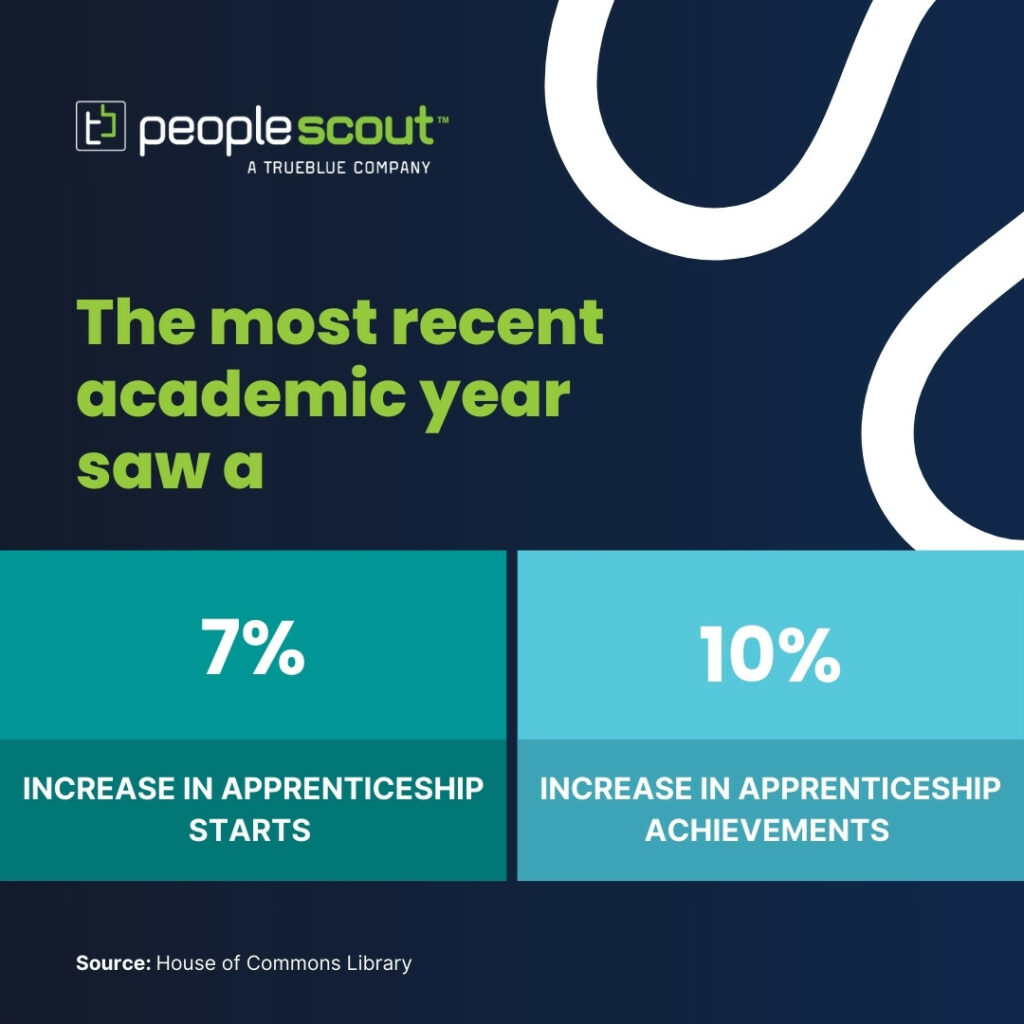
Types of Apprenticeships
A common misperception is that apprenticeships are just for manual or skilled trade jobs. Whilst there are many apprenticeship programs in the skilled trades, there are also apprenticeship opportunities for all kinds of careers from actuaries to arborists. For example, our client, National Highways, offers apprenticeship opportunities for project management, business administration, legal, surveying and data analysis. Organizations are increasingly embracing corporate apprenticeships and traineeships as a means of diversifying their workforce and creating opportunities for social mobility.
There are different levels of apprenticeship including degree apprenticeships which correspond to an equivalent education level. Completing a Level 2 apprenticeship is the equivalent of completing a GCSE, and a Level 7 apprenticeship is the equivalent of completing a master’s degree.
Benefits of Apprenticeship Recruitment for Employers
Apprenticeship recruitment can be an effective way of growing and upskilling your workforce. Here are just a few of the benefits for employers.
Building a Talent Pipeline
Companies in a variety of industries can build their own apprenticeship programs to help talent see the rewarding career opportunities available within their sector. As apprentices gain experience, organizations establish a pipeline of prospective employees.
Early careers employees see apprenticeship programs as proof of an organization’s investment in their success and are more likely to stay with an organization after completing the program. In fact, 80% of apprentice employers say they have seen a significant increase in employee retention. Clearly, apprenticeship recruitment is an excellent way to “grow your own talent” and reduce attrition.
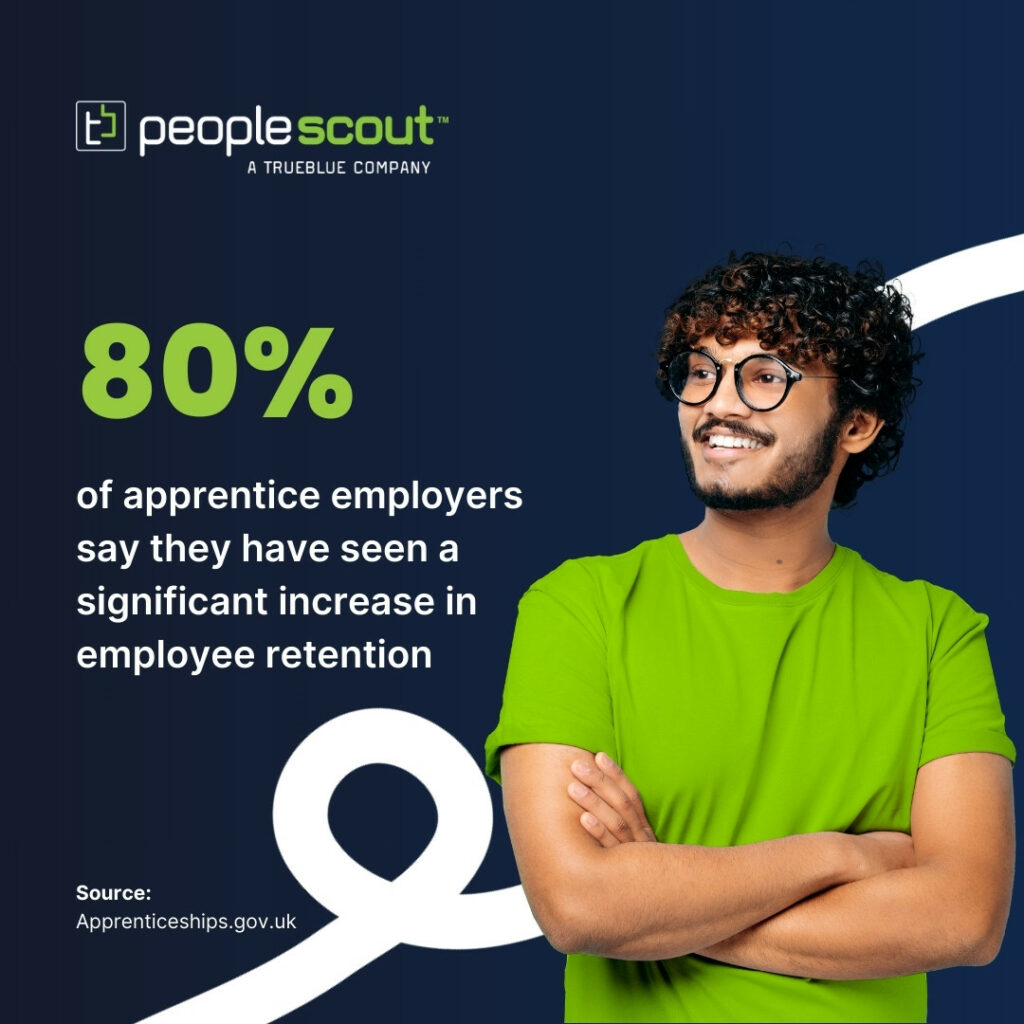
Closing Skills Gaps
According to McKinsey, a whopping 87% of organizations are aware they already have a skills gap within their workforce or will experience one in the next few years. Apprenticeships offer a way to develop a new generation of workers to help your organization succeed into the future. A structured apprenticeship is an effective way to get a leg up in recruiting and retaining sought-after talent like software developers, data analysts and engineers. Indeed, 86% of employers said that investing in apprentices helped to develop relevant skills for the organization.
The digital skills gaps alone could cause 14 G20 countries to miss out on a staggering $11.5 trillion USD in cumulative GDP growth. In the UK, companies like Dyson are partnering with the University of Warwick to offer apprenticeship training in engineering, data science and machine learning.
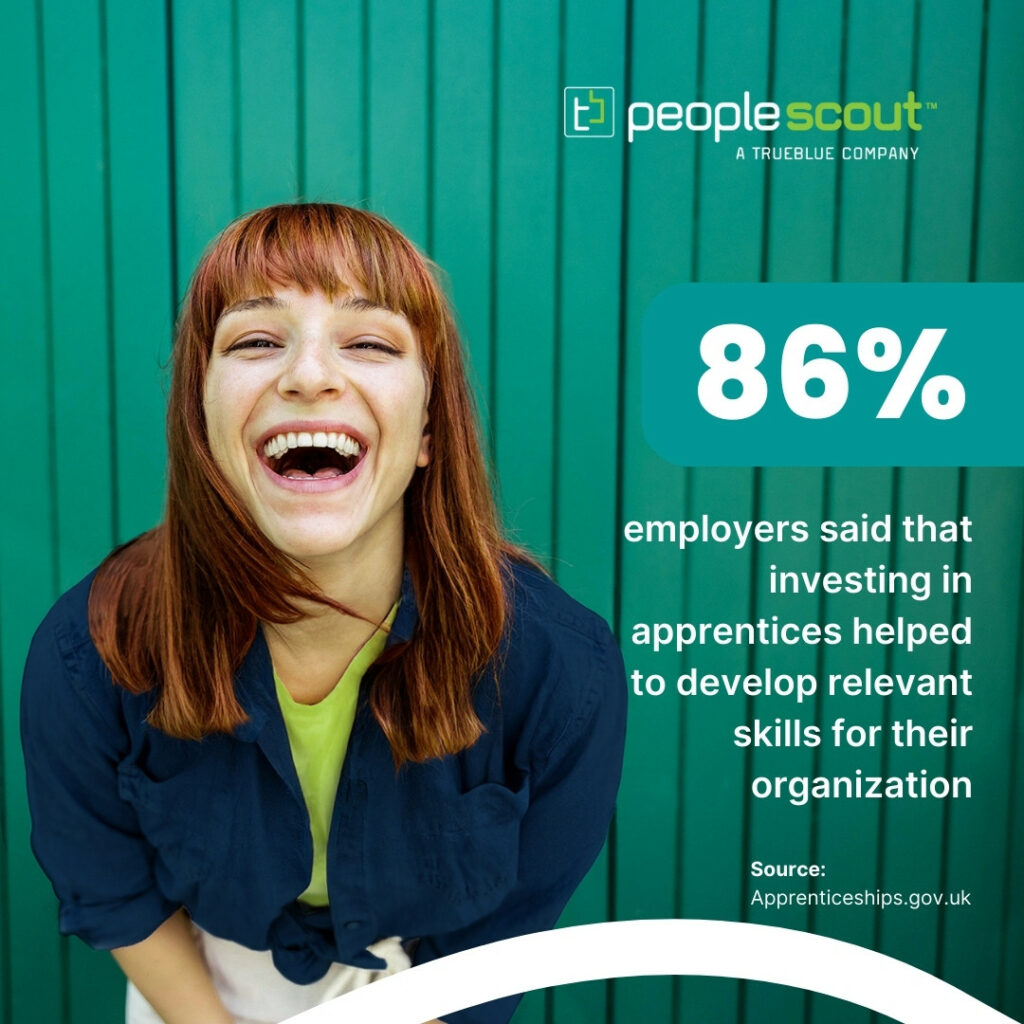
Boosting Diversity & Social Mobility
A third of employers agree that apprenticeships have helped improve diversity within their business. They are particularly effective for creating career opportunities and boosting earnings for workers from disadvantaged socio-economic backgrounds.
As more people struggle financially with student loans and education costs, apprenticeships have become an accessible career path for workers of all ages and backgrounds and give participants a shot at career success. They allow workers from underrepresented groups to increase their earnings potential—to work and earn money in the field while they learn. If your company cares about being a catalyst for sustained change in the community, apprenticeships are a great way to achieve this.
RPO + Apprenticeship Recruitment
As a leading recruitment process outsourcing (RPO) provider, PeopleScout helps organizations to obtain the talent and skills they need to succeed into the future through early careers recruitment solutions covering interns, graduates and apprenticeship programs. Unlike apprenticeship recruitment agencies, as an RPO partner, our expertise in talent acquisition strategy and workforce planning means we’re better equipped to successfully integrate apprentice programs into your overall talent attraction and training strategy. Plus, we have experts on staff that can design an assessment center that evaluates apprentice candidates against your organization’s values, culture and other requirements.
Professional Search: Sourcing a Transformative Leader to Boost Diversity in Schools

Situation
When the Office for Standards in Education, Children’s Services and Skills (Ofsted), the regulator for services for children and young people in England, revealed they would be implementing changes to their framework, our client, a local government agency in the UK, knew that the Director of Education and Skills position, which had been put on hold and filled by interim leaders for several years, needed to become a top priority.
The agency recognized there was a lack of teacher diversity which didn’t reflect the community. Plus, although progress had been made, there was still a need to focus on special educational needs and disabilities (SEND). On top of these challenges, Good and Outstanding ratings from Ofsted had dropped.
To counter this, they were looking for a new director with SEND experience who could build relationships with education leaders to get the best out of the area’s diverse schools–putting social justice at the heart of the community while maintaining achievement and attainment.
The agency turned to PeopleScout for our Apex senior professional hiring solution.
Solution
The PeopleScout Apex team took an extensive brief from the Executive Director, benchmarked profiles to further refine our search and presented a target list of people to approach which the client approved. Alongside this outreach, PeopleScout processed all candidates generated through advertising using the same method as the proactively sourced candidates to ensure a fair and open process.
PeopleScout performed a first round of interviews, presenting the qualifying candidates to the client for consideration with a written report for each. We partnered with the client in the technical interview, providing comprehensive feedback and recommendations to inform the final shortlisting process. A PeopleScout Apex team member was also present at the final interviews to provide advice and guidance.
Results
Altogether, we identified and reached out to 59 potential candidates. Out of these 54 people engaged, resulting in a 92% engagement rate. Nine candidates were selected for the first stage of interviews with three proceeding to the final round. Ultimately, one hire was made.
- 59 candidates identified
- 54 engaged
- 9 interviewed at first stage
- 3 interviewed at second stage
“Thanks very much for all the support from PeopleScout for the recent recruitment of our Director of Education and Skills. We have been impressed with the quantity and caliber of candidates—which has been recognized by the selection committee. Thanks for an overall professional service.”
Head of Internal Communications & Organizational Development
Neurodiverse Recruitment: 6 Ways to Make Your Hiring Process More Neuro-Inclusive
Neurodiverse recruitment unlocks a wealth of unique strengths, offering employers access to exceptional skills in pattern recognition, analysis, mathematics and beyond. This approach to hiring isn’t just inclusive—it’s a catalyst for innovation. By building cognitively diverse teams that blend neurodivergent and neurotypical talent, organizations supercharge their creativity, decision-making and problem-solving capabilities. The result? A dynamic workforce that drives efficiency and innovation to new heights.
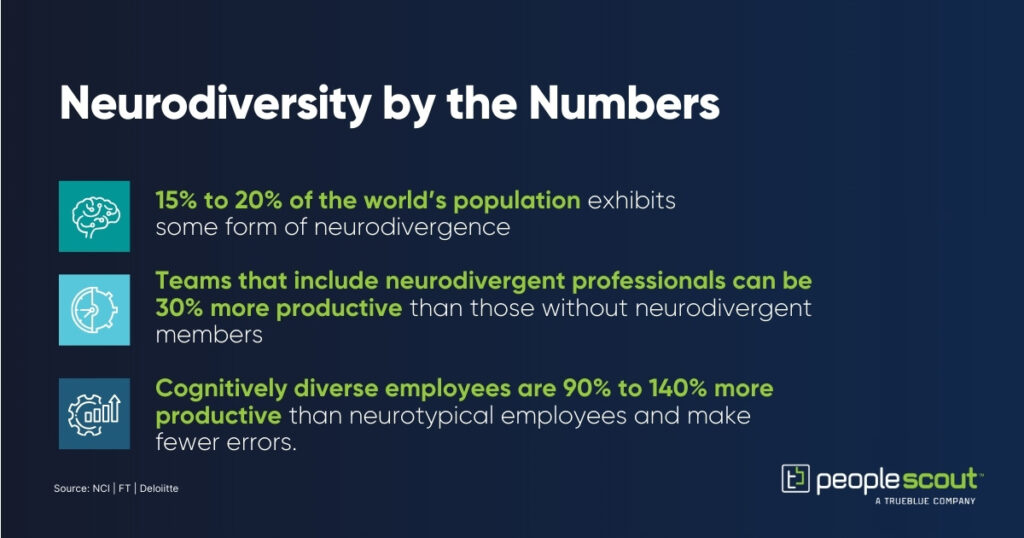
The untapped potential of neurodivergent talent is staggering, with alarming underemployment rates that rob both candidates and companies of incredible opportunities. In the U.S., it is estimated that as many as 85% of college-educated autistic adults struggle with unemployment. The Office for National Statistics (ONS) paints an equally grim picture for the UK, with just 21.7% of autistic individuals employed. In Australia, 70% of new starters with disabilities do not survive the probation period, while 65% of Australian businesses remain unsure about how to access this rich talent pool.
While many organizations aspire to build a workforce that harnesses the potential of the neurodivergent community, few achieve this goal. While the reasons behind this gap are multifaceted, there’s a critical knowledge gap about neurodiversity in the workplace and how to create neuro-inclusive hiring processes.
Ready to move the needle on neurodiverse recruitment? Let’s dive into five strategies that will transform your hiring process and unlock the full potential of neurodivergent talent.
What is Neurodiversity?
First, let’s define what we mean by neurodiversity. Neurodiversity refers to the concept that everyone experiences and interacts with the world around them differently. A neurodivergent person’s brain may work in a different way than the average “neurotypical” person. They may have unique ways of learning, communicating, working, socializing or perceiving their surroundings.
While neurodiversity is often used in the context of autism spectrum disorder (ASD) and Asperger’s syndrome, many conditions fall under the neurodivergent umbrella, including ADHD, dyslexia, dyspraxia, Down syndrome, Tourette syndrome, and even mental health conditions like bipolar disorder, OCD and social anxiety.
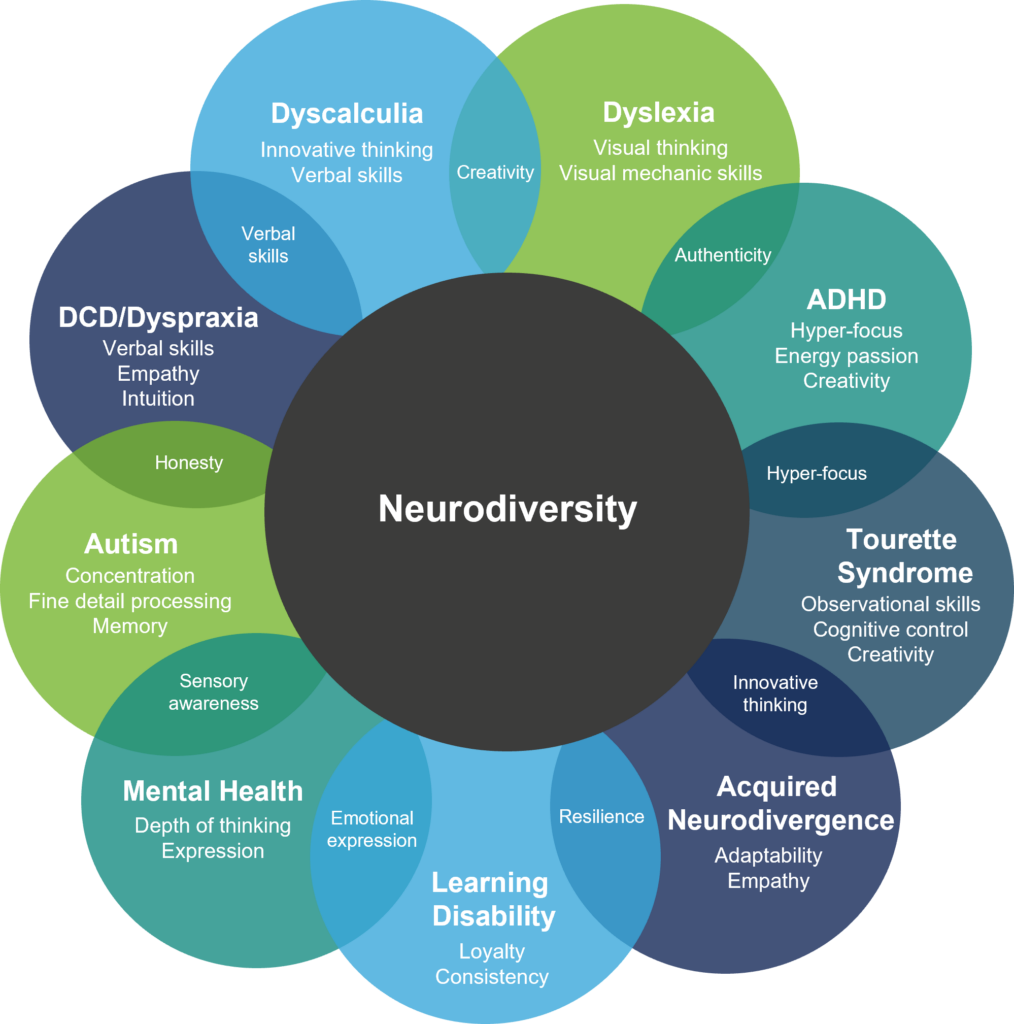
6 Strategies for Neurodiverse Recruitment
There’s no one-size-fits-all solution for neuro-inclusive recruitment, as neurodiversity encompasses a wide range of conditions, many of which may be undiagnosed or undisclosed. The key is to create a flexible process that can be tailored to individual needs.
1. Identify Roles for Neurodivergent Recruitment
To identify roles for neurodivergent talent, companies need to think beyond traditional job categories and focus on the core skills and tasks involved. Analyze and pinpoint positions that require deep focus, pattern recognition or systematic thinking—areas where many neurodivergent individuals excel. Look for roles that benefit from attention to detail, data analysis, quality control or creative problem-solving.
Tech roles often offer a goldmine of opportunities, from software development to cybersecurity. But don’t limit yourself—neurodivergent talent can thrive in unexpected places. Consider positions in finance, research, design or even customer service roles that involve script-based interactions.
You might also consider job carving, which involves customizing job roles by reorganizing tasks to create a new, tailored position that aligns with an individual’s strengths and abilities. This approach not only benefits neurodiverse employees by providing them with roles tailored to their abilities but also helps organizations make the most of their diverse workforce.
The key is to break down jobs into their fundamental components and match them with the unique strengths often associated with neurodiversity. Remember, it’s about recognizing where neurodivergent traits can be a significant asset to your existing needs.
2. Audit the Application Process for Neurodivergent Recruitment
Once you’ve identified roles where neurodiverse talent can thrive, it’s time to audit the application process. Put on your detective hat and scrutinize every step. Is it neurodiversity-friendly, or is it secretly working against you?
First start with the job description. Consider replacing lengthy, jargon-filled job descriptions with clear, concise summaries of the core responsibilities. Embrace inclusive language that speaks to diverse cognitive styles. Think less “excellent multitasker” and more “deep focus on specialized tasks.”
Then, move onto the application itself. Complex, multi-step applications can overwhelm candidates with conditions like ADHD or autism, potentially causing them to abandon the process altogether. Simplify application forms by asking only for essential information. You could even consider offering alternative submission methods, like video applications.
Ditch the requirement for cover letters in favor of skill-based assessments that directly relate to the job. By streamlining the application step, you level the playing field and tap into a rich pool of often-overlooked talent.
3. Communicate Early & Often
Be direct with your language and deliver information in multiple ways. Some candidates will be okay with written instructions, others like those with dyslexia, may receive information better through videos or audio explanations.
Start by providing a clear preview of the entire recruitment journey. Communicate each stage, what the candidate will be required to do and how they’re being evaluated. This transparency benefits all candidates but is particularly crucial for neurodivergent individuals who may need to prepare mentally for each phase.
Maintain frequent, personalized communication throughout the process. Strategic follow-ups can keep candidates engaged and comfortable, increasing the likelihood of offer acceptance. This ongoing dialogue also provides opportunities for candidates to ask questions or request additional accommodations as needed.
4. Balance Assessments & Interviews
Making the interview and assessment steps more neuro-inclusive is crucial for tapping into the diverse talent pool of neurodivergent candidates. While interviews shouldn’t be eliminated entirely, consider balancing them with other evaluation methods.
Shift the focus from traditional metrics to a strength-based evaluation approach. Look for candidates’ unique capabilities and how they align with job requirements, rather than adhering strictly to conventional interview performance criteria. For candidates requiring adjustments, you might weigh interviews less heavily in your overall evaluation, focusing more on practical skill demonstrations or work samples.
When it comes to assessments, large, complex exercises can be overwhelming for some neurodivergent candidates. Break these down into smaller tasks and add in the option to take breaks. Additionally, consider offering extra time for assessments if needed, focusing on the quality of work rather than speed of completion.
A blended assessment approach that incorporates multiple question styles and task types is great option for assessing neurodivergent talent. For instance, at Heathrow we introduced a completely bespoke virtual testing platform called One Experience Assessment (1XP) to recruit for their security officer roles. This included visual “spot the difference” exercises alongside traditional questions, providing a realistic job preview while allowing candidates to demonstrate their skills in different ways.
5. Be Prepared to Provide Accommodations & Adjustments for Neurodiverse Recruitment
Organizations should proactively prepare to provide reasonable adjustments and accommodations for neurodiverse candidates during the recruitment process. Flexibility should be a cornerstone of your approach as everyone has unique needs.
Be prepared to offer extra time for assessments, adjusting standard time limits or breaking longer tasks into manageable chunks. Additionally, be open to changing the location or format of interviews or allowing the use of assistive technology like screen readers during online assessments. Provide interview questions in advance to make the experience more accessible for those who process information differently.
Neurodiverse candidates may experience “sensory overload” in office environments and during in-person interactions. To help candidates better focus on demonstrating their skills and qualifications, design interview spaces with adjustable lighting, offer noise-canceling headphones and provide multiple seating options. These seemingly small adjustments can significantly reduce sensory sensitivity and anxiety.
6. Customize Onboarding & Beyond
Creating effective onboarding programs for neurodiverse employees is crucial for integration into the workplace and their long-term success. Recognize that each neurodivergent employee may have different needs and preferences, and be prepared to tailor the onboarding experience accordingly.
Training is a cornerstone of successful integration. This should be a two-way street, involving both the neurodiverse employee and their colleagues. Provide education and diversity training to managers and team members in advance of or early in the onboarding process. These sessions should sensitively address the characteristics and preferences of neurodivergent individuals, always respecting privacy and dignity. For instance, explain that a colleague with autism might avoid eye contact, helping coworkers understand this isn’t a sign of disinterest. Similarly, managers should be trained on how to introduce neurodiverse team members appropriately, avoiding potentially uncomfortable situations like introductions in large group settings.
Once neurodiverse employees start work, any adjustments offered during recruitment should be available in the workplace as well, ensuring a seamless transition from candidate to employee. By anticipating and preparing for these accommodations, organizations create an environment where neurodiverse candidates can thrive. This may also require implementing flexible working patterns that play to individual strengths. Offering adjustable work hours, remote work options or customized workspaces can help minimize sensory overwhelm.
To further support neurodiverse employees, consider developing growth opportunities tailored to the unique needs of neurodivergent employees. This could include specialized mentorship programs or coaching sessions that focus on leveraging their strengths and navigating workplace challenges. By implementing these strategies, companies can create an onboarding experience that not only welcomes neurodiverse talent but sets them up for long-term success and growth within the organization.
The Importance of Neurodivergent Recruitment
Embracing neurodiverse recruitment is not only a step towards inclusivity but a strategic move that leverages the unique strengths of this group to foster innovation and enhance performance. By closing the knowledge gap and implementing targeted strategies, organizations can create a more inclusive work environment that truly maximizes the potential of all employees, leading to a more dynamic and productive workforce.
